A great deal of my attention lately is on the nature of authenticity.
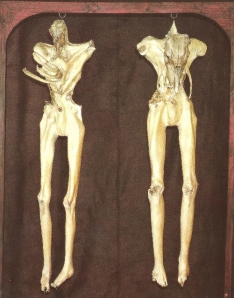
Untitled, 1982 by Jane Alexander
It is simpler to determine if something is honest, is true to itself, than it is to determine if something is authentic, that it is what it claims to be, and is original.
In a digital environment, the idea of being [an] original is almost meaningless. A copy that is a relatively close descendant of the original is a clone. But of course, as one gets further from the first iteration, anomalies, accidents, and errors occur. In a graphic a pixel gets dropped here or there during the copy or distribution process, noise is introduced and voila, we have evolution. The deviant may still be ‘honest’, that is, a faithful representation of the original, but it is not authentic.
Stories told in the analog world of griots, story-tellers, may be honest and have integrity, but they are not original. They are not expected to be. Each griot would be judged for the honesty of their report, of getting the story straight, but honor and fame came from the nuance, the depth of their presentation.
In our digital domain however, things tend to get repeated more or less exactly with little variation. Ours is an age of cut-and-paste talking points, of rigid positions passed among groups. The news ‘loop’ that plays the same 15 second visual over and over because there is no other visual information about the event that is admitted, or the technique of repeating something over and over again, exactly, with no variation or nuance until it becomes functionally valid are two technical examples. Also to consider is that in a predominantly digital domain, the presentation is flat, appearing on a 2 dimensional screen, for now. Even if we become enamored of 3-D technology, it has still only the appearance of depth. In an analog world of poetry, songs, theater and dance, all these are 3 dimensional. They have actual depth.

P.W. Botha or Haley Barbour?
So with all that said, my attention was turned this week to a statement made by John Dittmer, Professor Emeritus of History at DePauw University in Indiana on Democracy Now, discussing Governor Haley Barbour’s personal but historically inaccurate statements about the Citizen’s Councils of Mississippi. What caught my eye was the pull-quote that Governor Barbour was an “unreconstructed Southerner.”
It is of course an odd turn of phrase. I might not have been quite so interested if Mr. Dittmer had said “unrepentant.” In this case it means the same thing, but it would not contain the irony of saying that a Southerner should undergo the process of ‘Reconstruction’ in order to be made morally correct. It is the collective punishment of the South following the war applied directly to an individual in the 21st century.
Amy Goodman asked the direct, and to my mind ridiculous, arrogant and irrelevant question, ‘Is Governor Barbour a racist?’ The exact quote (as provided by their transcript) and the answer warrants posting here.
AMY GOODMAN: Governor Barbour’s spokesperson has insisted that Governor Barbour is not a racist. What do you think?
JOHN DITTMER: Well, I think when you get to labeling people racist, it’s like calling people Nazis. It’s that the conversation veers away and becomes a matter of semantics. As I said, I think that Barbour is an unreconstructed Southerner and, as such, is not sensitive to the struggles of African Americans. And there’s no indication, as governor or as president, that he would be sensitive. And I think this is the major issue. Whatever his motivations are, his conduct has been reprehensible.”
Pasted from <http://www.democracynow.org/seo/2010/12/22/barbour_is_an_unreconstructed_southerner_prof>
Excuse me? Barbour is an ‘unreconstructed Southerner’ and therefore is not, and cannot be, sensitive to the struggles of African Americans? Maybe he is or maybe he isn’t, but the extraordinary and bald-faced Supremacy contained in that twisted logic is repulsive. Or should I just say that the statement is reprehensible?
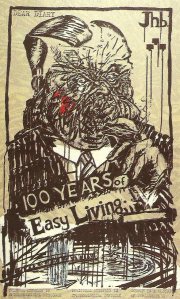
Art in a State of Seige by William Kentridge
Let no one say that I am an apologist for Governor Barbour. I have a joke that goes: “What these commentators don’t understand is that Haley Barbour wants to be President of the Confederacy, not the Union. Why would a Southerner want to be President of the North?” This is clearly a joke.
But slandering someone as a racist and declaring that they are in need of some good, old-fashioned ‘reconstruction’ or a more modern ‘reeducation’, is clearly not a joke.
In Barbour’s case, he is repeating the often heard and pervasive myth of the ‘happy slave’. In Goodman’s and Dittmer’s case, they are applying the often heard and pervasive myth of Southern inferiority in intelligence and social morality. Each is a flat, two-dimensional reproduction of 150 year-old propaganda talking points. Barbour, Goodman and Dittmer may be completely honest in their expression of who they believe they are and who their opponents are, but they are certainly not being authentic, and I suspect they know it, or at least feel it.
Professor Dittmer makes another interesting observation here, doing well as an historian, but it must be read carefully:
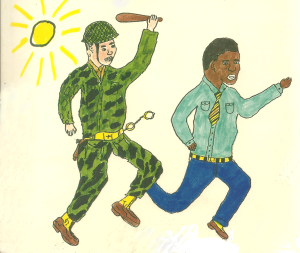
Cover, "Two Dogs and Freedom"
“JOHN DITTMER: Well, I think what we’re getting into here—and this goes beyond Mississippi—is that we’re getting into the sesquicentennial of the Civil War, and there are going to be—it’s going to be observed all throughout the South. And what we’re finding as historians now is that we have to go back and talk again that slavery was the cause of the Civil War. What we’re getting from many people in positions of authority in the South is, this was the war between the states. There are going to be celebrations, commemorations. And yet, the real reason for the war and the reasons why slavery existed in the first place are not going to be discussed. So this is part of a larger problem that we’re going have to deal with, I think, on a regular basis.” [my emphasis]
What Professor Dittmer is saying, and this is being echoed elsewhere – notably on the Daily Show – is that historians (and comedians) are going to have to once again reinforce the truth that the Civil War was about slavery, not State’s Rights as ‘many people in positions of authority in the South’ say it was. This is true, and the discussion of why slavery existed in the first place, and morality aside, why it was unacceptable are probably not going to be discussed.
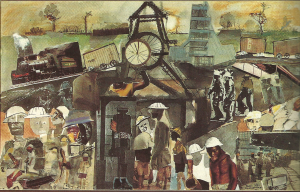
Shaft, 1987 by Sam Nhlengethwa
So briefly here is my perspective:
The Civil War was not the start of the dissolution of the Union, but its historic opportunity to emerge. The ‘Union’ was formed as a federation of independent states which began as separate royal charters, i.e. corporations. Those favoring independence from England knew that the states must be united by what amounted to a mutual defense treaty because if they weren’t, it would be a simple matter for European powers to contest and carve up the North American continent exactly as they were doing in the Caribbean, South America, Asia and Africa. So it was necessary to work out the 3/5ths compromise as part of the power-sharing arrangement that could establish the alliance.
This unsustainable arrangement held for a while, but the contradictions between the Northern industrial economy and the Southern agricultural slave economy were unavoidable. Modern industrial economies are incompatible with chattel slavery. To the northern economy, the South looked increasingly like an undeveloped market unavailable because of slavery, and as a source of cheap uneducated labor to depress the wages of whites. (We can see this still in play elsewhere today. The first thing a modern industrial economy must do is destroy the local cooperative agricultural economy, as it did in Haiti.)
It is no accident that the secessionist movement developed in a defensive reaction to the growing industrial power of the North when the European powers in the post-Napoleonic period were in no position to step in as a foreign threat. France had just lost Haiti and been forced to sell its entire claim to the mid-continent, the Louisiana Purchase, for a pittance. Of course ‘states rights’ were not discussed as a basis for secession, but those arguments were the political vector for the defense of the Southern economy, which required slavery to function. Slavery was the economic foundation of the South. Without slavery, no significant amount of wealth could be produced from agriculture. Everywhere in the world, slavery has been the mechanism for accumulating wealth from large-scale agriculture since large-scale agriculture began. It is not a surprise that the South (meaning the economic powers in the South) wanted to maintain their economic base. And the path of ‘state’s rights’ as a political ploy was there from before Independence Day.
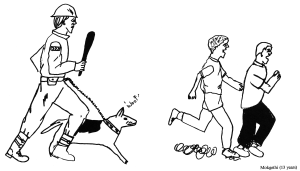
from Two Dogs and Freedom
We humans always want to make a morality play out of every drama, but economics and history don’t work that way; they are amoral. Both racism and anti-racism are easily fomented by opinion makers. But those moral or immoral positions are not the forces that actually move events on a macro scale; economics is.
We have no hope of changing the discourse of the people involved in generating the ideological talking points on any side of this discussion. The political and entertainment industries, the ‘politainment sector’, are moved solely by their economic interests, which are considerable. We do not have the reeducation camps or reconstruction facilities adequate to the task. But as a matter of individual behavior, I might suggest that we try to keep as much 3 dimensional, analog thinking in our lives as possible. Let us conduct ourselves with resonance and real depth-perception. And let us avoid at all costs any notion that we personally, or our side collectively holds any higher divine or moral ground than those we quarrel with, even though it may appear obvious.
Graphic Credits from top to bottom:
1. Untitled, 1982 by Jane Alexander. Wax, paint, bone, plaster of paris, wood, steel. University of Witwatersrand, S.A.
2. P.W., 1985 by Dr. Phutuma Seoka. Velvet Corkwood, paint.
3. Art in a State of Seige, 1988 by William Kentridge. Silkscreen
4. Cover of “Two Dogs and Freedom”, by Ishmael, age 14. Published by Rosset & Company, NY, 1987 (thanks Lisa)
5. Shaft, 1984 by Sam Nhlengethwa. Collage on paper.
6. Woof, by Mokgethi, age 13. from Two Dogs and Freedom, ibid
7. original photo taken atop Table Mountain, Capetown, S.A., 1990.
1,2,3 and 5 from Resistance Art in South Africa by Sue Williamson. St. Martins Press, NY, 1989.








ReEducation UnReConstructed
A great deal of my attention lately is on the nature of authenticity.
Untitled, 1982 by Jane Alexander
It is simpler to determine if something is honest, is true to itself, than it is to determine if something is authentic, that it is what it claims to be, and is original.
In a digital environment, the idea of being [an] original is almost meaningless. A copy that is a relatively close descendant of the original is a clone. But of course, as one gets further from the first iteration, anomalies, accidents, and errors occur. In a graphic a pixel gets dropped here or there during the copy or distribution process, noise is introduced and voila, we have evolution. The deviant may still be ‘honest’, that is, a faithful representation of the original, but it is not authentic.
Stories told in the analog world of griots, story-tellers, may be honest and have integrity, but they are not original. They are not expected to be. Each griot would be judged for the honesty of their report, of getting the story straight, but honor and fame came from the nuance, the depth of their presentation.
In our digital domain however, things tend to get repeated more or less exactly with little variation. Ours is an age of cut-and-paste talking points, of rigid positions passed among groups. The news ‘loop’ that plays the same 15 second visual over and over because there is no other visual information about the event that is admitted, or the technique of repeating something over and over again, exactly, with no variation or nuance until it becomes functionally valid are two technical examples. Also to consider is that in a predominantly digital domain, the presentation is flat, appearing on a 2 dimensional screen, for now. Even if we become enamored of 3-D technology, it has still only the appearance of depth. In an analog world of poetry, songs, theater and dance, all these are 3 dimensional. They have actual depth.
P.W. Botha or Haley Barbour?
So with all that said, my attention was turned this week to a statement made by John Dittmer, Professor Emeritus of History at DePauw University in Indiana on Democracy Now, discussing Governor Haley Barbour’s personal but historically inaccurate statements about the Citizen’s Councils of Mississippi. What caught my eye was the pull-quote that Governor Barbour was an “unreconstructed Southerner.”
It is of course an odd turn of phrase. I might not have been quite so interested if Mr. Dittmer had said “unrepentant.” In this case it means the same thing, but it would not contain the irony of saying that a Southerner should undergo the process of ‘Reconstruction’ in order to be made morally correct. It is the collective punishment of the South following the war applied directly to an individual in the 21st century.
Amy Goodman asked the direct, and to my mind ridiculous, arrogant and irrelevant question, ‘Is Governor Barbour a racist?’ The exact quote (as provided by their transcript) and the answer warrants posting here.
Excuse me? Barbour is an ‘unreconstructed Southerner’ and therefore is not, and cannot be, sensitive to the struggles of African Americans? Maybe he is or maybe he isn’t, but the extraordinary and bald-faced Supremacy contained in that twisted logic is repulsive. Or should I just say that the statement is reprehensible?
Art in a State of Seige by William Kentridge
Let no one say that I am an apologist for Governor Barbour. I have a joke that goes: “What these commentators don’t understand is that Haley Barbour wants to be President of the Confederacy, not the Union. Why would a Southerner want to be President of the North?” This is clearly a joke.
But slandering someone as a racist and declaring that they are in need of some good, old-fashioned ‘reconstruction’ or a more modern ‘reeducation’, is clearly not a joke.
In Barbour’s case, he is repeating the often heard and pervasive myth of the ‘happy slave’. In Goodman’s and Dittmer’s case, they are applying the often heard and pervasive myth of Southern inferiority in intelligence and social morality. Each is a flat, two-dimensional reproduction of 150 year-old propaganda talking points. Barbour, Goodman and Dittmer may be completely honest in their expression of who they believe they are and who their opponents are, but they are certainly not being authentic, and I suspect they know it, or at least feel it.
Professor Dittmer makes another interesting observation here, doing well as an historian, but it must be read carefully:
What Professor Dittmer is saying, and this is being echoed elsewhere – notably on the Daily Show – is that historians (and comedians) are going to have to once again reinforce the truth that the Civil War was about slavery, not State’s Rights as ‘many people in positions of authority in the South’ say it was. This is true, and the discussion of why slavery existed in the first place, and morality aside, why it was unacceptable are probably not going to be discussed.
Shaft, 1987 by Sam Nhlengethwa
So briefly here is my perspective:
The Civil War was not the start of the dissolution of the Union, but its historic opportunity to emerge. The ‘Union’ was formed as a federation of independent states which began as separate royal charters, i.e. corporations. Those favoring independence from England knew that the states must be united by what amounted to a mutual defense treaty because if they weren’t, it would be a simple matter for European powers to contest and carve up the North American continent exactly as they were doing in the Caribbean, South America, Asia and Africa. So it was necessary to work out the 3/5ths compromise as part of the power-sharing arrangement that could establish the alliance.
This unsustainable arrangement held for a while, but the contradictions between the Northern industrial economy and the Southern agricultural slave economy were unavoidable. Modern industrial economies are incompatible with chattel slavery. To the northern economy, the South looked increasingly like an undeveloped market unavailable because of slavery, and as a source of cheap uneducated labor to depress the wages of whites. (We can see this still in play elsewhere today. The first thing a modern industrial economy must do is destroy the local cooperative agricultural economy, as it did in Haiti.)
It is no accident that the secessionist movement developed in a defensive reaction to the growing industrial power of the North when the European powers in the post-Napoleonic period were in no position to step in as a foreign threat. France had just lost Haiti and been forced to sell its entire claim to the mid-continent, the Louisiana Purchase, for a pittance. Of course ‘states rights’ were not discussed as a basis for secession, but those arguments were the political vector for the defense of the Southern economy, which required slavery to function. Slavery was the economic foundation of the South. Without slavery, no significant amount of wealth could be produced from agriculture. Everywhere in the world, slavery has been the mechanism for accumulating wealth from large-scale agriculture since large-scale agriculture began. It is not a surprise that the South (meaning the economic powers in the South) wanted to maintain their economic base. And the path of ‘state’s rights’ as a political ploy was there from before Independence Day.
from Two Dogs and Freedom
We humans always want to make a morality play out of every drama, but economics and history don’t work that way; they are amoral. Both racism and anti-racism are easily fomented by opinion makers. But those moral or immoral positions are not the forces that actually move events on a macro scale; economics is.
We have no hope of changing the discourse of the people involved in generating the ideological talking points on any side of this discussion. The political and entertainment industries, the ‘politainment sector’, are moved solely by their economic interests, which are considerable. We do not have the reeducation camps or reconstruction facilities adequate to the task. But as a matter of individual behavior, I might suggest that we try to keep as much 3 dimensional, analog thinking in our lives as possible. Let us conduct ourselves with resonance and real depth-perception. And let us avoid at all costs any notion that we personally, or our side collectively holds any higher divine or moral ground than those we quarrel with, even though it may appear obvious.
Graphic Credits from top to bottom:
1. Untitled, 1982 by Jane Alexander. Wax, paint, bone, plaster of paris, wood, steel. University of Witwatersrand, S.A.
2. P.W., 1985 by Dr. Phutuma Seoka. Velvet Corkwood, paint.
3. Art in a State of Seige, 1988 by William Kentridge. Silkscreen
4. Cover of “Two Dogs and Freedom”, by Ishmael, age 14. Published by Rosset & Company, NY, 1987 (thanks Lisa)
5. Shaft, 1984 by Sam Nhlengethwa. Collage on paper.
6. Woof, by Mokgethi, age 13. from Two Dogs and Freedom, ibid
7. original photo taken atop Table Mountain, Capetown, S.A., 1990.
1,2,3 and 5 from Resistance Art in South Africa by Sue Williamson. St. Martins Press, NY, 1989.
Share this:
Related